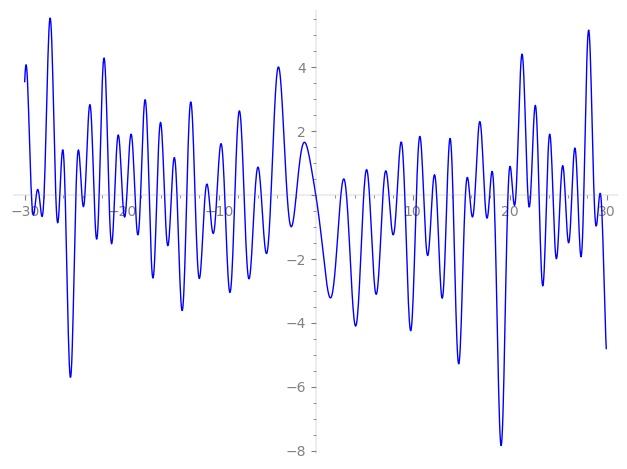| L(s) = 1 | + (−0.190 − 0.330i)2-s − 0.381·3-s + (0.927 − 1.60i)4-s + (−0.190 + 0.330i)5-s + (0.0729 + 0.126i)6-s − 1.47·8-s − 2.85·9-s + 0.145·10-s − 4.85·11-s + (−0.354 + 0.613i)12-s + (−2.5 + 2.59i)13-s + (0.0729 − 0.126i)15-s + (−1.57 − 2.72i)16-s + (−3.73 + 6.47i)17-s + (0.545 + 0.944i)18-s + 4.85·19-s + ⋯ |
| L(s) = 1 | + (−0.135 − 0.233i)2-s − 0.220·3-s + (0.463 − 0.802i)4-s + (−0.0854 + 0.147i)5-s + (0.0297 + 0.0515i)6-s − 0.520·8-s − 0.951·9-s + 0.0461·10-s − 1.46·11-s + (−0.102 + 0.177i)12-s + (−0.693 + 0.720i)13-s + (0.0188 − 0.0326i)15-s + (−0.393 − 0.681i)16-s + (−0.906 + 1.56i)17-s + (0.128 + 0.222i)18-s + 1.11·19-s + ⋯ |
\[\begin{aligned}\Lambda(s)=\mathstrut & 637 ^{s/2} \, \Gamma_{\C}(s) \, L(s)\cr =\mathstrut & (-0.803 - 0.595i)\, \overline{\Lambda}(2-s) \end{aligned}\]
\[\begin{aligned}\Lambda(s)=\mathstrut & 637 ^{s/2} \, \Gamma_{\C}(s+1/2) \, L(s)\cr =\mathstrut & (-0.803 - 0.595i)\, \overline{\Lambda}(1-s) \end{aligned}\]
Particular Values
| \(L(1)\) |
\(=\) |
\(0\) |
| \(L(\frac12)\) |
\(=\) |
\(0\) |
| \(L(\frac{3}{2})\) |
|
not available |
| \(L(1)\) |
|
not available |
\(L(s) = \displaystyle \prod_{p} F_p(p^{-s})^{-1} \)
| $p$ | $F_p(T)$ |
|---|
| bad | 7 | \( 1 \) |
| 13 | \( 1 + (2.5 - 2.59i)T \) |
| good | 2 | \( 1 + (0.190 + 0.330i)T + (-1 + 1.73i)T^{2} \) |
| 3 | \( 1 + 0.381T + 3T^{2} \) |
| 5 | \( 1 + (0.190 - 0.330i)T + (-2.5 - 4.33i)T^{2} \) |
| 11 | \( 1 + 4.85T + 11T^{2} \) |
| 17 | \( 1 + (3.73 - 6.47i)T + (-8.5 - 14.7i)T^{2} \) |
| 19 | \( 1 - 4.85T + 19T^{2} \) |
| 23 | \( 1 + (2.23 + 3.87i)T + (-11.5 + 19.9i)T^{2} \) |
| 29 | \( 1 + (-2.04 + 3.54i)T + (-14.5 - 25.1i)T^{2} \) |
| 31 | \( 1 + (4.35 + 7.54i)T + (-15.5 + 26.8i)T^{2} \) |
| 37 | \( 1 + (2 + 3.46i)T + (-18.5 + 32.0i)T^{2} \) |
| 41 | \( 1 + (2.61 - 4.53i)T + (-20.5 - 35.5i)T^{2} \) |
| 43 | \( 1 + (-3.78 - 6.54i)T + (-21.5 + 37.2i)T^{2} \) |
| 47 | \( 1 + (1.11 - 1.93i)T + (-23.5 - 40.7i)T^{2} \) |
| 53 | \( 1 + (4.11 + 7.13i)T + (-26.5 + 45.8i)T^{2} \) |
| 59 | \( 1 + (1.11 - 1.93i)T + (-29.5 - 51.0i)T^{2} \) |
| 61 | \( 1 + 6T + 61T^{2} \) |
| 67 | \( 1 - 0.708T + 67T^{2} \) |
| 71 | \( 1 + (4.09 + 7.08i)T + (-35.5 + 61.4i)T^{2} \) |
| 73 | \( 1 + (-1 - 1.73i)T + (-36.5 + 63.2i)T^{2} \) |
| 79 | \( 1 + (2 - 3.46i)T + (-39.5 - 68.4i)T^{2} \) |
| 83 | \( 1 + 6.70T + 83T^{2} \) |
| 89 | \( 1 + (8.04 + 13.9i)T + (-44.5 + 77.0i)T^{2} \) |
| 97 | \( 1 + (6.07 + 10.5i)T + (-48.5 + 84.0i)T^{2} \) |
| show more | |
| show less | |
\(L(s) = \displaystyle\prod_p \ \prod_{j=1}^{2} (1 - \alpha_{j,p}\, p^{-s})^{-1}\)
Imaginary part of the first few zeros on the critical line
−10.18714678372792025162868558901, −9.385204885034420512337350535831, −8.333604882163238787259929773251, −7.38729008597001431775717312410, −6.27242090166650313935153716975, −5.62005578126017163805885598093, −4.60954723869384635520296905504, −2.94912396629309653339228610913, −2.00527308999423146027154061936, 0,
2.59550403565865417696718474522, 3.16748509140987734906855591612, 4.95170586053693634784177388736, 5.53756554414450238262609527407, 6.93190067328791730404683455113, 7.54322386340171729115201190047, 8.380001488722985264309081015692, 9.175503516444045614660392955669, 10.38007379119849548121637713621

